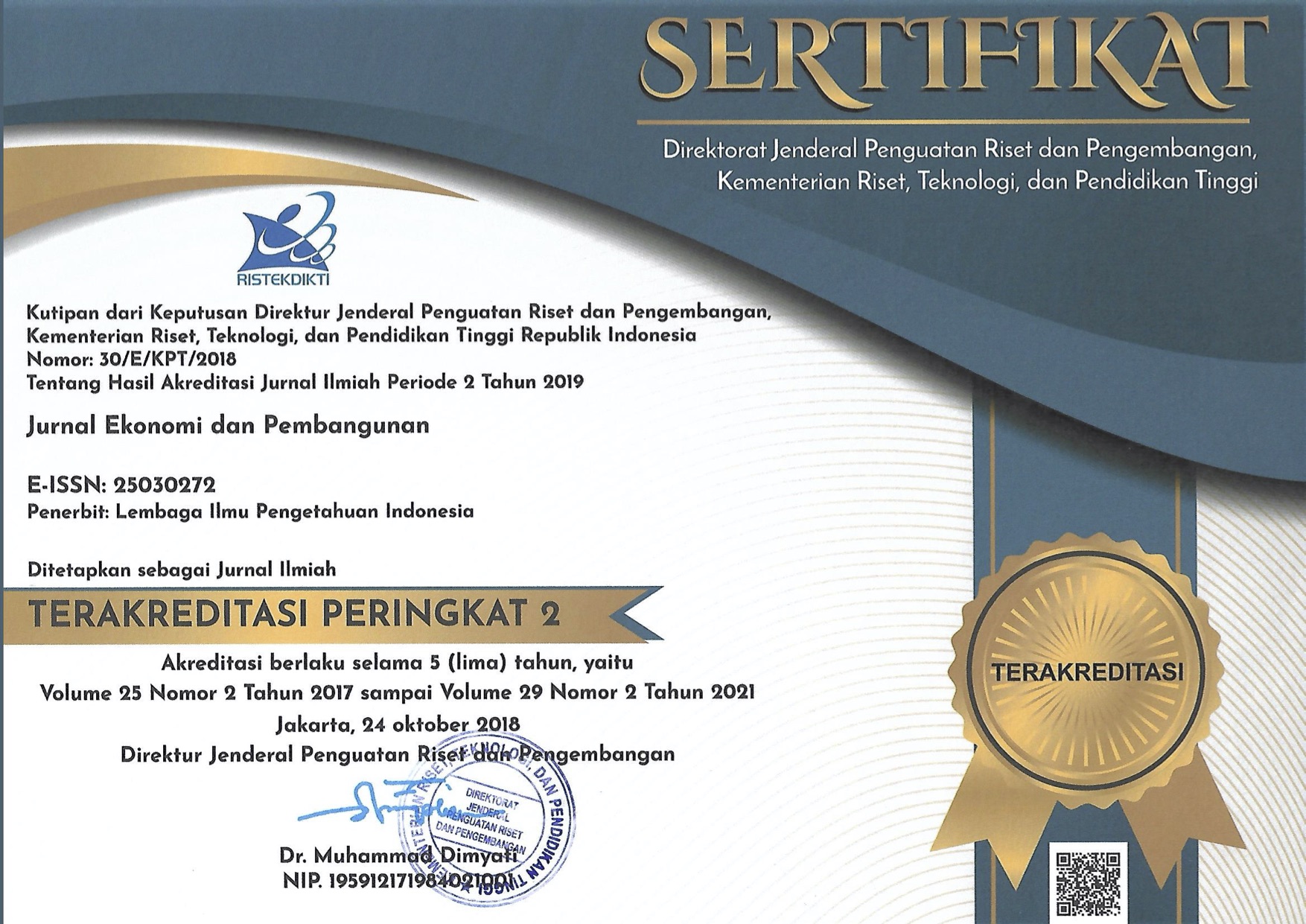SEGITIGA KEMISKINAN-PERTUMBUHAN-KETIMPANGAN (PGI TRIANGLE): PEMBANGUNAN KEUANGAN, PEMBANGUNAN MANUSIA, DAN KETIMPANGAN PENDAPATAN DI ASIA
Abstract
One of the issues faced by countries in asia is income inequality. Economic development is expected to improve
peoples living standards to minimize the gap between low-income and high-income populations. One of economic
development is through financial development. The financial sector plays an important role in the economy of a
country, the development of the financial sector will indirectly increase the output of other sectors so as to tie the
value of the gross domestic product (gdp). In addition to equality and economic growth, economic development
also needs to see whether the two are related to human development as described in the poverty-growth-inequality triangle (pgi triangle). The purpose of this study is to see a picture of the inequality of income distribution, financial development and human development in six asian countries. The analysis used descriptive statistics and panel data regression, specifically fixed effect model (fem) and the random effect model (rem). The result showed that there is a significant influence between financial development and human development on income inequality, the higher the financial development will reduce the level of inequality of a country. Meanwhile, the high value of human development actually increases inequality.
Downloads
References
Bank Indonesia. (2014). Buku Saku Keuangan Inklusif: Survey Neraca Rumah Tangga BI.
Bappenas. (2012). Rasio Gini di Indonesia dalam Lima Tahun Terakhir Trend Peningkatan Ketimpangan.
Bourguignon, F. (2004). The Poverty-Growth-Inequality Triangle.
Buhaerah, P. (n.d.). Pengaruh Finansialisasi Terhadap Ketimpangan Pendapatan Di Asean : Analisis Data Panel. 335–352.
Carroll, A. E., & Frakt, A. (2017). What Makes Singapore’s Health Care So Cheap? The New York Times. Diambil dari https://www.nytimes.com/2017/10/02/upshot/what-makes-singapores-health-care-so-cheap.html
Galor, O., & Zeira, J. (1993). Income Distribution and Macroeconomics. Review of Economic Studies, 60(1), 35–52.
Kopf, D. (2017). China ’ s extreme income inequality finally appears to be falling.
Kuznets, S. (1955). The American Economic Review. American Economic Association, 45(1), 1–28. https://doi.org/10.1257/aer.99.1.i
Levine, R. (2005). Chapter 12 Finance and Growth: Theory and Evidence. Handbook of Economic Growth. https://doi.org/10.1016/S1574-0684(05)01012-9
Rajan, R. G., & Zingales, L. (2003). The great reversals: The politics of financial development in the twentieth century. Journal of Financial Economics. https://doi.org/10.1016/S0304-405X(03)00125-9
Sen, A. (1976). Poverty: An Ordinal Approach to Measurement. Econometrica. https://doi.org/10.2307/1912718
Shaw, E., & McKinnon, R. (1973). World Economy Financial Repression 1. Money.
Todaro, M. P. (2006). Pembangunan Ekonomi Di Dunia Ketiga. In Economic Development. https://doi.org/2003
Tukey, J. W. (1977). Exploratory Data Analysis. Addison Wesley.
UNDP. (2013). Human Development Report 2013 Summary. In Vasa.
Copyright (c) 2020 Jurnal Ekonomi dan Pembangunan

This work is licensed under a Creative Commons Attribution-NonCommercial-ShareAlike 4.0 International License.
Terms and Conditions of Publication
1. Author's Rights and Authorities
As an author, you (or your employer or institution) may do the following:
-
make copies (print or electronic) of the article for your own personal use (not for commercial purpose), including for your own classroom teaching use;
-
make copies and distribute such copies (including through email) of the article to research colleagues, but not allowed to distribute commercially and systematically, e.g. via an email list or list server;
-
present the article at a meeting or conference and to distribute copies of the article to the delegates attending such meeting;
-
retain all proprietary rights in any process, procedure, or article of manufacture described in the work;
-
include the article in full or in part in a thesis or dissertation;
-
use the article or any part thereof in a printed compilation of your works, such as collected writings or lecture notes, and other derivative works, with full acknowledgement to JEP as the original journal publishing the article;
-
may reproduce material extracted from the article or derivative works for the author's personal use, but must consider the copyrights procedure.
All copies, print or electronic, or other use of the paper or article must include the appropriate bibliographic citation for the article’s publication in the journal.
2. Requests from Third Parties
Although authors are permitted to re-use all or portions of the article in other works, this does not include granting third-party requests for reprinting, republishing, or other types of re-use. Requests for all uses not included above, including the authorization of third parties to reproduce or otherwise use all or part of the article (including figures and tables), should be referred to P2E-LIPI by going to our website at http://ekonomi.lipi.go.id/.
3. P2E LIPI Copyright Ownership
Economic Research Center, the Indonesian Institute of Sciences (P2E-LIPI) owns the copyrights to reproduce, distribute, disseminate, translate, and other uses in accordance with the existing Laws and Regulations.
Every accepted manuscript should be accompanied by "Copyright Transfer Agreement" prior to the article publication.

This work is licensed under a Creative Commons Attribution-NonCommercial 4.0 International License.
JEP Journal by P2E-LIPI is licensed under a Creative Commons Attribution-NonCommercial-ShareAlike 4.0 International License. Permissions beyond the scope of this license may be available at http://jurnalekonomi.lipi.go.id/index.php/JEP
If you are a nonprofit or charitable organization, your use of an NC-licensed work could still run afoul of the NC restriction, and if you are a for-profit entity, your use of an NC-licensed work does not necessarily mean you have violated the term.






